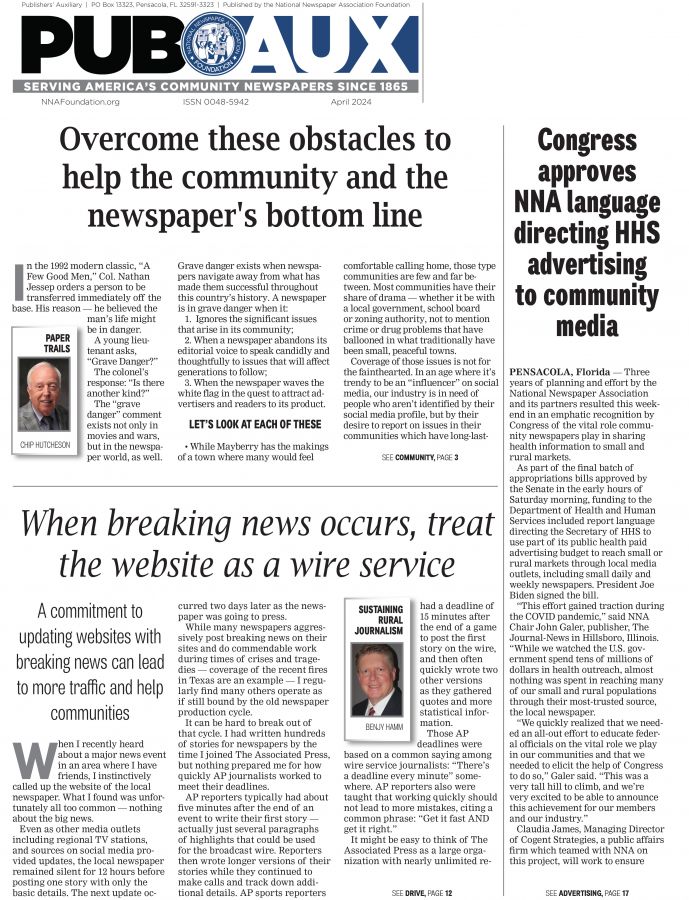Young people do still read news in papers
Feb 16, 2015
By Kevin Slimp
Software Review
I really don’t mean to get this worked up about things. Oh, sorry. I sometimes digress. Let me catch you up.
While taking a drive through the Smoky Mountains, about 45 minutes from my home, I stopped to fill up and check my messages before heading into Townsend, a small town known as the “Peaceful side of the Smokies.”
Checking my messages, I noticed an e-mail from a professor at one of the larger universities in my home state of Tennessee. It was in response to a message I had sent out a day earlier, concerning a collegiate media summit being held in Nashville this month.
He wrote to let me know that he feared not many would attend the event because “there are a number of college papers like us who are Web-only, or almost, throughout the state.”
I understand that he was trying to be helpful. But really? When I got back to my office, I pulled up the websites for student newspapers at The University of Tennessee, ETSU and Memphis University. All are print publications.
I wrote back to mention that it was an interesting time to pull out of print. A report in Business Insider just two days earlier indicated that advertising in newspapers was up 4 percent in 2014, while TV ad revenue was down 4 percent. I also noted that a recent study of journalism and mass communications graduates found that “Writing, reporting and editing for print remains the dominant” activities for those in the workforce after graduation.
I went on to mention that Kevin Schwartz, as respected as anyone in the collegiate media world, has written that moving away from print is a mistake for college newspapers.
He wrote back, “While print advertising may be up, it’s certainly not with our print product. But that’s not the main issue. What’s at stake is the kids in high school and college today, who do not or rarely read a printed newspaper on a regular basis.”
I’ve written a lot recently about the survey of more than 600 newspaper executives I completed, with the help of friends, a few weeks ago. I didn’t mention the survey to the professor. But I can’t help but think about all those publishers who reported things are going well, and they look to continue in a positive direction for decades to come.
Sorry. I’m digressing again. Back to the story.
It’s at times like these that I always start to feel guilty. What if the professor is right? What if young people really don’t read print anymore? Could I be wrong? Could the studies be wrong? After all, a lot of journalism professors I run into seem to think that print is dead. And so do most of the people I know who sell online services. Maybe they’re all right. Maybe young people do not read news in print anymore.
It was about that time that I decided to pull over to grab a bite of lunch. I pulled into the parking lot of AJ’s Hearth and Kettle Restaurant, just off 321 in Townsend, and made my way into the dining room.
I saw what must have been a hallucination, because over in the right corner sat a young woman, reading a newspaper.
I introduced myself and told her about the conversation I’d just had with the college professor. I asked her age. She smiled and said, “23.”
When I told her what the professor said about young people no longer reading newspapers, she laughed and said, “That’s just crazy. I read the newspaper every day.”
She told me her name was Stephanie and that she loved reading the newspaper. If I were 15 years younger, I would have dropped on one knee and proposed right there.
I asked if I could take her photo to use in my column and she smiled and said, “Sure.”
So what about the professor? Was he wrong or am I living in a fantasy world?
Or is Schwartz right? Are university newspapers cutting their noses to spite their faces? Are they giving up the basics learned in creating a printed newspaper for the sake of ease? Let’s face it: It’s a lot easier to create an online product than a printed product. Sure, it’s next to impossible to cover expenses through advertising revenue. But if you’re at a university that will fund an online product without the need to raise ad revenue, who can blame them?
Right now, as I write, three brand new newspapers are starting up in my hometown of Knoxville. Two of them are looking to young readers as a target market. This is in addition to the two papers already targeted to the college market. Apparently, I’m not the only one who thinks young people still read papers.
There I go, digressing again. © Kevin Slimp 2015
Kevin Slimp is director of the Institute of Newspaper Technology. To read his past columns, go to www.kevinslimp.com. To learn about the institute, go to www.newspaperinstitute.com.







